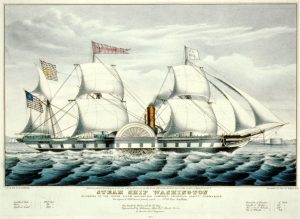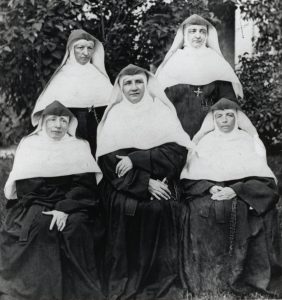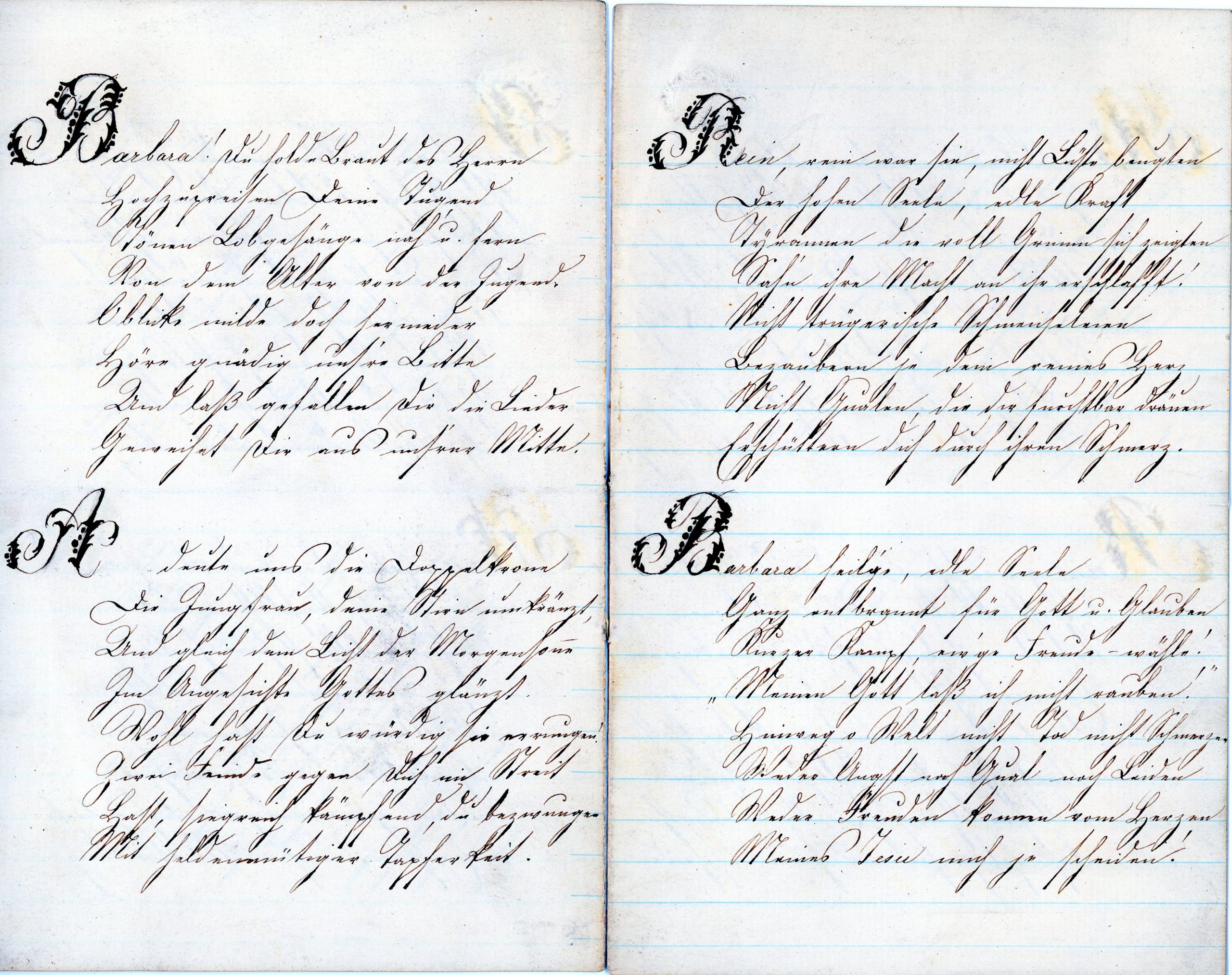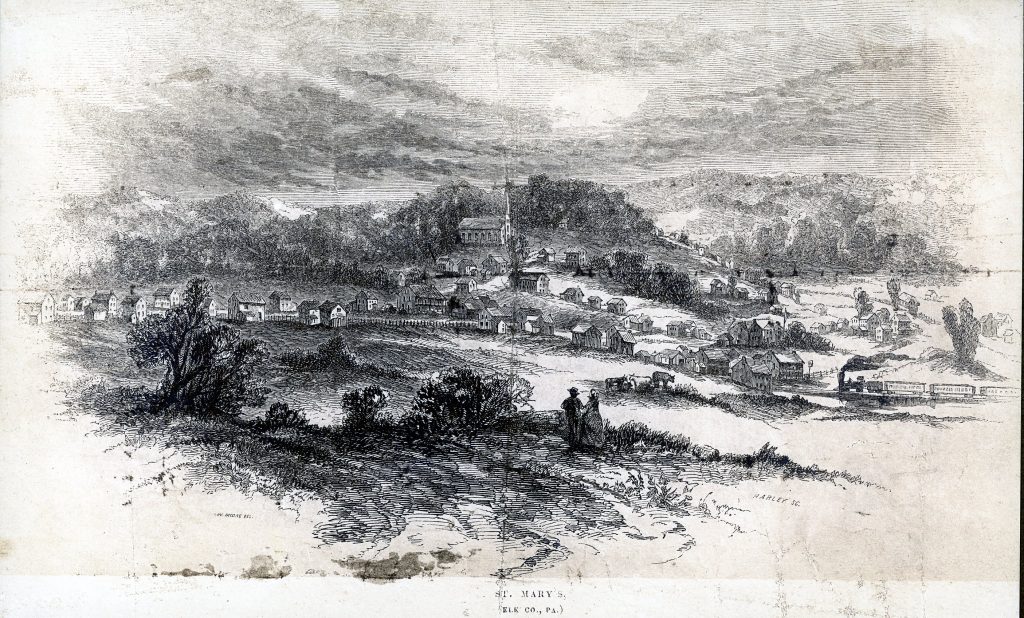“Yesterday, Friday, July 30 [1847], at five in the evening, we set foot on solid ground for the first time in America – in New York.” Blessed Theresa of Jesus Gerhardinger wrote these words at the end of the long and arduous trip from Munich to New York. She left Bavaria with the intention of establishing a motherhouse in a small settlement in St. Mary’s, Pennsylvania.

Steamship Washington Lithograph. Provided by Library of Congress.
On that day, the first six School Sisters of Notre Dame stepped off a ship called the Washington and entered a new mission field. Blessed Theresa quickly learned that things in America were not what she had been led to expect. Despite setbacks, including the death of one of her party, she continued to press forward to establish a foundation in North America.
The sisters who stepped off that ship could never have envisioned all that they and their spiritual descendants who followed would accomplish – opening hundreds of parish schools throughout the United States and Canada; founding colleges, high schools and institutes dedicated to educating young women; establishing mission extensions around the world; creating programs to assist people living in poverty; branching out into fields that would never have been conceivable to women in the mid-19th century; and affecting the lives of untold men and women throughout the world.
For the next year, the staff at the School Sisters of Notre Dame North American Archives will celebrate the past 175 years of SSND history in North America by highlighting SSND “firsts.” Each month will focus on a particular sister, event or mission that has a unique place in the congregation’s history in the United States and Canada. To begin, we will start with the very first “first” – the foundation of the congregation in North America.

These women were some of the early SSND pioneers who came to North America, though not all pictured were part of that first group that came with Blessed Theresa. Click the photo to learn more. (back row, l-r) Sister Theophila Bauer and Sister Seraphica Mitchell; (front row, l-r) Sister Seraphina von Pronath, Mother Caroline Friess and Sister Emmanuela Schmid
First SSND in North America
Shortly after arriving in New York, Blessed Theresa and her five companions traveled to St. Marys, a German Catholic immigrant settlement located in the forests of Pennsylvania. They hoped to open a school and establish a motherhouse, but shortly after their arrival in New York, they learned that there was little promise of success at St. Marys. Since the sisters had no means of support and did not have the support of any American bishops, they were advised to return to Munich.
Trusting in God’s call, Blessed Theresa and her sisters did not turn back. By the end of September, they opened their first mission school for girls in St. Marys. Convinced that this was not a suitable location for a motherhouse, Blessed Theresa traveled to Baltimore where she was helped by St. John Neumann. Through his efforts, the School Sisters of Notre Dame were able to purchase a convent and were given charge of three German parish schools in that city: St. James, St. Alphonsus and St. Michael.
The lives of Blessed Theresa and Mother Caroline Friess, who accompanied Blessed Theresa to America, are well-known in the congregation, but they did not work alone. What about the other four women who ventured across the Atlantic Ocean with them? In addition to being the first SSND in North America, their group included the first provincial for the Baltimore province, the first SSND to die in North America, and the first to open missions in four states. It is time to learn more about Sisters Mary Barbara Weinzierl, Seraphina von Pronath, Magdalena Steiner and Novice Emmanuela Breitenbach.
Sister Mary Barbara Weinzierl
Barbara Weinzierl was born on April 11, 1811, the daughter of a brewer and innkeeper, in Pfaaffenberg, Bavaria. She attended school at the Royal School for Girls in Stadtamhof, Germany and was taught by Caroline Gerhardinger (the future Blessed Theresa). After she finished school, she returned home but felt a calling to religious life. She wanted to enter the Ursuline convent, but first she had to become qualified to teach elementary school. In 1830, Barbara turned to her former teacher, Caroline, and in 1830 she began to teach with her.
On October 24, 1833, Caroline, Barbara and Maria Blass moved to a convent in Neunburg vorm Wald, Bavaria. On November 16, 1835, Caroline took religious vows and chose the name Mary Theresa of Jesus. On April 10, 1836, Barbara became one of the first six novices received into the congregation. She was given the religious name Mary (although in later years she was usually known as Sister Mary Barbara). She professed her first vows in 1838. According to her obituary, Sister Mary Barbara was the first student of the first mother of the congregation.

Nameday tribute to Mother Mary Barbara Weinzierl given in Baltimore, 1864. What is a nameday? Click the photo to learn more.
Sisters Mary Barbara and Seraphina were assigned as the first teachers at St. Marys, located in rural Pennsylvania. Sister Mary Barbara remained until the mission closed in November 1849. After she left St. Marys, she served in Pittsburgh and Buffalo before moving to the Milwaukee Motherhouse.
In 1857, she was assigned to serve as the superior of St. James in Baltimore, Maryland. She remained there for 12 years before moving to St. Louis for a year, and then returning to Baltimore in 1870. In 1876, the Baltimore Province was established and Sister Mary Barbara was appointed as the first provincial. Four months after the appointment, a letter arrived from the Generalate in Munich stating that Sister Mary Barbara was “too old” to serve as provincial, and Sister Jacobina Diener was named as her successor. In February 1877, Mother Caroline arrived in Baltimore at the request of Archbishop Bayley, who had written stating that the sisters in Baltimore did not recognize Sister Jacobina as the provincial. With the approval of the Generalate, Sister Theophila Bauer was chosen as Sister Mary Barbara’s successor with Sister Jacobina serving as a member of the provincial council.
In September 1879, Sister Mary Barbara was chosen as one of the four North American delegates sent to the first General Chapter in Munich. The meeting was called to select a new Superior General to replace Mother Theresa, who died in May 1879. Sister Mary Barbara was weakened by the trip and the decision was made that she would remain in Munich. She died there on September 24, 1891.
Sister Seraphina von Pronath
Elise von Pronath was born in 1817 at Offenberg Castle in Bavaria. Her father acquired the castle in 1802 from an impoverished count, although he did not move there until 1811. Two years later he married his second wife, a member of a noble Italian family that had immigrated to Germany in the 17th century. Elise’s life was one of great wealth, education and privilege, yet she chose to serve God by entering religious life.
Elise entered the congregation on October 28, 1838, and received the name Seraphina. She professed her vows the following year and spent the next eight years teaching music at several schools in Germany. In 1847, she answered Mother Theresa’s call to enter the new mission field of St. Marys, Pennsylvania. Sisters Seraphina and Mary Barbara Weinzierl were assigned to serve as the first teachers at St. Marys.
In July 1848, Mother Theresa prepared for her return to Munich. She knew that she needed to appoint someone to serve as superior in Baltimore, but she had concerns about the two best candidates, Sisters Caroline Friess and Seraphina. She wrote, “If we had only one convent, a cloistered one, I would prefer Sister Seraphine because the spirit of the order would not suffer. To govern beyond the convent is not for Sister Seraphine, however. Since Sister Caroline is young and inexperienced, she would need to be guided, humbled, and instructed for five or six years first…” In the end she chose Sister Seraphina.

St. Marys, Pennsylvania
Sister Seraphina served as first superior of St. James in Baltimore until 1858. Over the next decade, Sister Seraphina was responsible for establishing four missions in four states, three of which were the first missions in that particular state: St. Joseph in St. Louis, Missouri; St. Mary in Richmond, Virginia; St. Mary in Fort Wayne, Indiana; and Blessed Sacrament in Hokah, Minnesota (Hokah was the second mission in Minnesota).
Mother Theresa’s assessment of Sister Seraphina was clearly correct; she was skilled at running convents, and she proved by mettle numerous times. In 1859, Sister Seraphina, another professed sister and a candidate were sent to open a school for 60 girls in Richmond. In 1861, the sisters found themselves in the middle of the beginnings of a civil war. The south had seceded from the United States, and the Confederate government made Richmond their capital city.
All correspondence between the North and the South was suspended, and as a result, there is little information about what the sisters in Richmond experienced during the war. In 1863, Mother Theresa wrote that Sister Seraphina’s sister had visited the Motherhouse looking for information about her sister. She was concerned because Sister Seraphina had not answered her letter informing her of their mother’s death. At one point, Sister Seraphina was able to travel to Baltimore, but not much is known about this trip.
In 1869, Sister Seraphina was working at St. Peter’s School in Hokah, Minnesota, when she began experiencing heavy nosebleeds. Concerned, Mother Caroline recalled her to the Milwaukee Motherhouse. From that date until her death, she worked as Mother Caroline’s assistant and a member of her council. In 1882, Mother Seraphina, as she became known, was appointed as the first superior of the Milwaukee Province.
Mother Seraphina died on August 27, 1884, at the Milwaukee Motherhouse. Her body laid in state in the Motherhouse chapel surrounded by fresh greens and lighted candles. On August 29, Mother Caroline, her councilors and the professed sisters accompanied Mother Seraphina’s body to Elm Grove for burial. As they approached the convent, they heard the chapel bells ringing and arrived to find the sisters with lighted candles awaiting their arrival.
Sister Magdalena Steiner
Anna Steiner was born in 1810 in Weiden, Germany. Anna, her mother, sister Caroline and an elderly servant lived together after her father’s death. In 1834, Anna and her sister applied for admission to the congregation. Unfortunately, their mother became ill with smallpox and died. The young women attended the funeral, but Caroline caught the disease and died a week after their mother. Anna provided the servant with lodging, money and all necessities, donated the greater part of her estate to the poor, and in 1834, she entered the congregation. She was one of the first six novices accepted into the congregation and was given the religious name Magdalena. She professed her vows in 1838 and served in several position before coming to America, including Novice Mistress and Mother Theresa’s secretary.
Sister Magdalena’s first assignment in the United States was teacher at St. James School in Baltimore (which would become the Baltimore Motherhouse in 1876). When Sister Seraphina was appointed as superior of St. James, Sister Magdalena was given the job of procurator at the convent. In 1858, she became the superior of St. Joseph’s Orphanage in Pittsburgh. According to her obituary, she dedicated herself to teaching and caring for the orphans during the day and at night she spent hours on household tasks, such as cleaning and laundry.
At some point, Sister Magdalena had contracted tuberculosis and was too weak to continue her work at the orphanage. In 1865, she was brought to the Milwaukee Motherhouse. Unfortunately, Sister Magdalena did not feel at home in Milwaukee and wanted to spend her remaining days in Baltimore. In an attempt to make her feel better, Mother Caroline would bring her on visitation tours. In 1867, the pair visited Baltimore and Sister Magdalena remained because she was too sick to travel. She died on November 5, 1867. She was laid out in the convent parlor, and on the day of the funeral, she was carried by six young women to St. James Hall, where her funeral was held (the church was under construction).
Her obituary described Sister Magdalena as such: “With all her virtues, she was extremely affable and humble and therefore sincerely loved and revered by all her companions – a good, gentle soul, a thoroughly reliable sister.”
Novice Emmanuela Breitenbach
Elizabeth Breitenbach was born in 1824 in Wurzburg, Germany. She entered the novitiate on January 20, 1847, and received the religious name Emmanuela. A few months later, Mother Theresa took the novice to America to serve as her companion for the return trip to Bavaria. Sister Emmanuela kept a journal of the voyage where she provided details about their journey, including information about local customs, people they met and places they visited.
On August 7, 1847, the group arrived in Baltimore. Shortly after their arrival, Sister Emmanuela became sick with diarrhea. In her correspondence, Mother Theresa worried about Emmanuela’s condition, which stressed their limited financial resources, as well as their timeline for getting to St. Marys. She wrote, “We had to call the doctor, and we have already spent five days at an expensive hotel. Today we must leave for St. Marys because the coaches are ordered and waiting for us.” Despite her illness, the decision was made for her to accompany the group to Pennsylvania.
The group travelled by stagecoach which journeyed over poorly constructed roads. Mother Caroline Friess wrote, “As a result, we were jolted unmercifully to and fro and often we were hurtled upward. How deeply concerned we were for our dear Sister Emmanuela who simply said smilingly, ‘That isn’t doing anything to me.’” The coach stopped in Harrisburg, Pennsylvania, and Mother Caroline wrote that Sister Emmanuela “forced herself with all remaining strength to get out of the stagecoach; no one could understand how she did it.”
She was put to bed and a doctor and priest were immediately called. The priest did not speak German, but he understood what was happening and gave the young woman absolution while the sisters stood around her praying. On August 11, 1847, Sister Emmanuela stopped breathing and her “holy soul had left this world.” It was an intensely hot August, so the sisters knew that the burial had to occur the following morning. They spent the night preparing Sister Emmanuela for burial by washing her body and clothing her in her habit. For the remainder of the night, they took turns praying for her.
Word of the novice’s death spread throughout Harrisburg, and in the morning, people came to view the body. Mother Caroline wrote that some came to mourn with the sisters and others out of curiosity, having never seen a Catholic sister wearing a religious habit. She was buried at the Catholic cemetery in Harrisburg.
Sister Emmanuela was the first SSND to die in North America and later generations thought it important to identify where she was buried. In 1926, a sister wrote to St. Patrick’s Cathedral in Harrisburg asking for information about Sister Emmanuela. According to a reply, the original cemetery was located in the church yard attached to the original St. Patrick’s Church. When the present Cathedral was built in 1905, the bodies in the old church yard were relocated to Mount Calvary Cemetery. The remains of many of the deceased buried in the old church yard were placed in boxes and interred together. Sister Emmanuela and two priests were buried in this way, but the exact location of their remains was not recorded.
